06-原型和原型链
文章目录
- 1. 认识原型
- 1.1 ES5 -- **对象**的原型
- 1.2 ES5 -- **构造函数**的原型
- 1.3 ES5 -- 重写原型对象(不推荐)
- 2. 原型链
- 2.1 ES5 -- 默认对象的原型链
- 2.2 ES5 -- 利用**原型链**实现继承
- 2.3 ES5 -- 借用**构造函数**实现属性继承
- 2.4 ES5 -- 原型式继承函数
- 2.5 ES5 -- 对象补充方法
- 3. 原型关系
- 3.1 原型继承关系图
- 3.2 ES6的`class`
- 3.2.1 class定义类
- 3.2.2 访问器
- 3.3 extends实现继承
认识一下原型和原型链。
1. 认识原型
原型是什么?怎样获取?
1.1 ES5 – 对象的原型
每个对象身上都有一个[[prototype]]内置属性,这个特殊的对象可以指向另外一个对象。
- 当我们通过引用对象的
key来获取value时,就会触发[[Get]]操作; - 这个操作首先会在对象本身进行寻找,如果有的话就使用它;
- 没有的话就在对象的[[prototype]]属性指向的对象中寻找,如果还没有的话就继续找对象[[prototype]]属性指向的对象的[[prototype]]属性指向的对象中寻找,直到找到或者找不到为止。
获取对象原型的方法
__proto__属性obj.proto
这种方式存在浏览器的兼容性问题,所以不建议使用;- getPrototypeOf()
Object.getPrototypeOf(obj)
同样的,设置原型可使用setPrototypeOf(对象,对象要指向的原型)方法;
const obj = {name: 'prototype'
}console.log(obj);console.log(obj.__proto__);
console.log(Object.getPrototypeOf(obj));
console.log(obj.__proto__ === Object.prototype); // true
1.2 ES5 – 构造函数的原型
函数本身也是对象,它身上有一个[[prototype]]属性,这个属性是一个对象,这个对象就是函数的实例对象。
区别于对象的获取方式,函数的[[prototype]]属性是显式原型,而函数对象的__proto__是隐式原型;
通过new关键字创建对象:
- 创建空对象;
- 将空对象赋值给this;
- 将对象的显式原型赋值给隐式原型;
案例:
function Student(name, age) {this.name = name;this.age = age;this.studying = function () {console.log(this.name + ' is studying');}
}const s1 = new Student('xuexi', 18);
const s2 = new Student('student', 18);console.log(s1.studying === s2.studying); // false
- 若这样定义函数,那么每次通过
new创建对象时都会创建一个新的studying方法; - 但若是将该方法定义在
Student.prototype对象中,那么studying方法只会创建一次,所有对象实例都会共享这个方法。
Student.prototype.studying = function () {console.log(this.name + ' is studying');
}
const s1 = new Student('xuexi', 18);
const s2 = new Student('student', 18);console.log(s1.studying === s2.studying); // true
函数的显式原型对象[[prototype]]上有一个[[constructor]]属性,和这个属性指向函数本身。
console.log(Student.prototype.constructor === Student); // true
案例:
function Person(name, age) {this.name = namethis.age = age
}const p1 = new Person('p1', 18)
const p2 = new Person('p2', 20)Person.prototype.running = function () {console.log(this.name + ' is running')
}
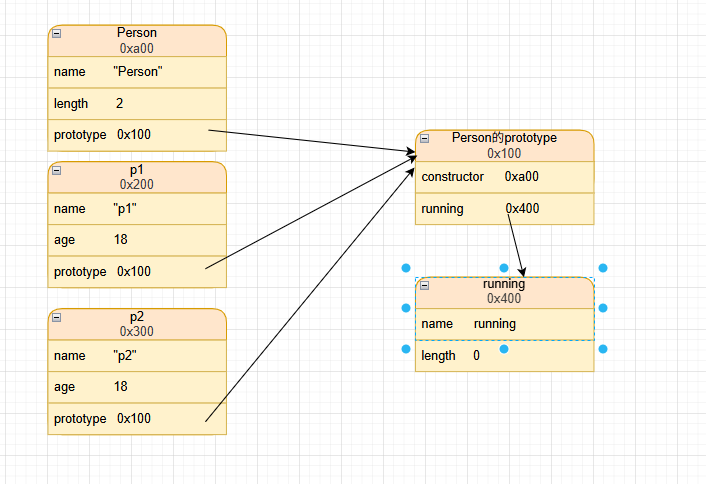
查找某个属性时,首先在对象本身中寻找,如果没有再在原型对象上寻找,如果没有再在原型对象的原型对象上(Object.prototype)寻找,直到找到或者找不到为止。
1.3 ES5 – 重写原型对象(不推荐)
如果要在原型对象上添加很多属性,那么我们一般会重写原型对象。
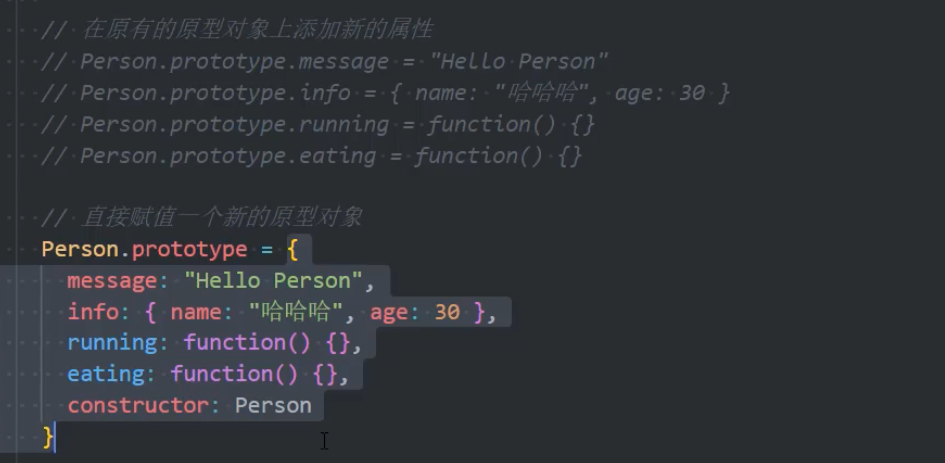
我们可以通过上面的方法重写原型对象,但注意不要忘记添加[[constructor]]属性。
在重写前我们发现原型对象的[[constructor]]的属性描述符是不可枚举的:
console.log(Object.keys(Person.prototype)) // ['running']
但是按照我们重写的方式来看,[[constructor]]属性也将会被枚举,所以我们需要通过属性描述符对这个属性进行更改。
Object.defineProperty(Person.prototype, "constructor", {configurable: true,value: "Person",enumerable: false,writable: true
})
2. 原型链
2.1 ES5 – 默认对象的原型链
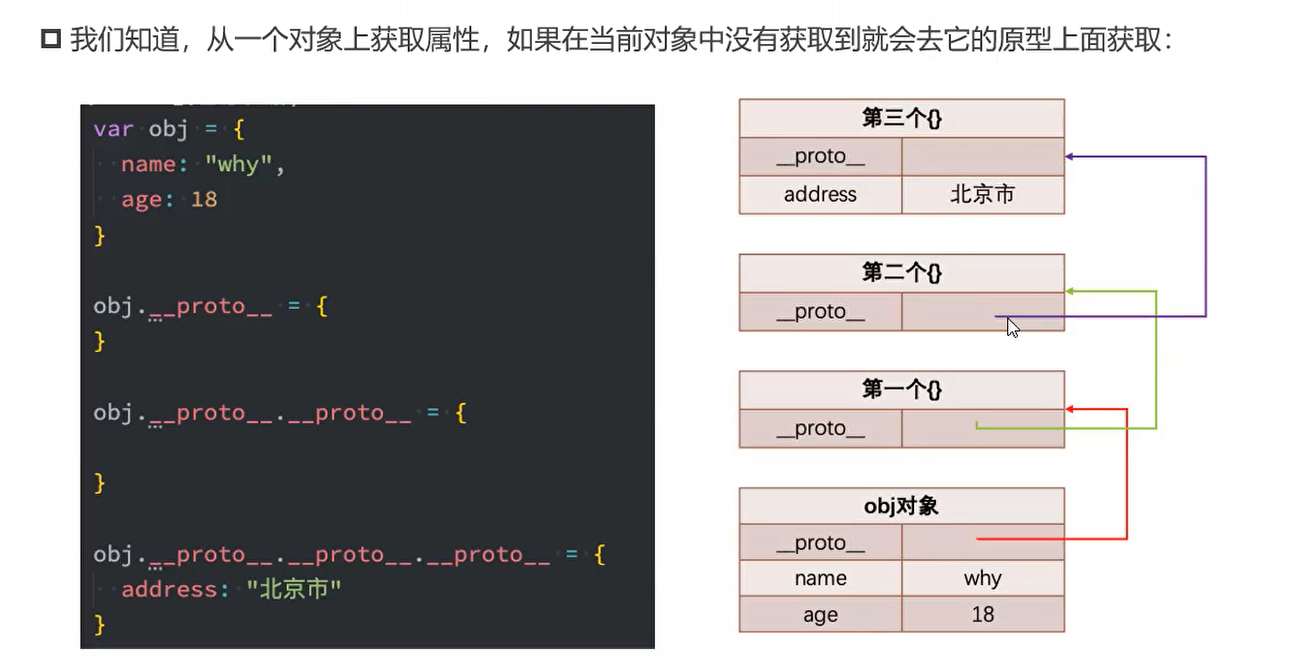
当在对象身上查找某个属性时,会现在真神寻找,自身没有会在原型__proto__上寻找,如果没有的话会在原型的原型__proto__上寻找,最终查找到Object.prototype,它指向null,直到找到或者找不到为止。
const obj = {};
// 相当于 const obj = new Object(); 构造函数的原型
// 即 obj.__proto__ = Object.prototype;
2.2 ES5 – 利用原型链实现继承
现定义一个Person类,定义一个Student类,实现Student继承Person。
function Person(name, age) {this.name = name;this.age = age;
}
Person.prototype.say = function () {console.log('hello world');
}
function Student(name, age) {this.name = name;this.age = age;
}
Student.prototype.say = function () {console.log('hello world');
}Student.prototype.studying = function () {console.log(this.name + ' is studying');
}-
方式一 –
Student.prototype = Person.prototype;这种方式会产生问题:
本来只有Student类才有的studying方法,但是通过这种方式,Student类和Person类都拥有studying方法。也就没有实现继承。 -
方式二 –
Student.prototype = new Person();Student.prototype = p;这种方式将
Student类的studying方法放在p对象身上,而Person原型上没有,实现了继承。
2.3 ES5 – 借用构造函数实现属性继承
// 在利用原型链实现继承的基础上
function Student(name, age) {Person.apply(this,name,age)this.name = name;this.age = age;
}const student = new Student("chender", 22)
组合继承的弊端
- 创建对象时,会调用两次父类的构造函数,一次是
Student.prototype = new Person();,一次是Student.prototype = p;; - 所有的子类实例都有两份父类的属性,一份在自身,一份在原型上;
2.4 ES5 – 原型式继承函数
从上面的例子中可以发现,想要实现继承就需要将父类和子类连接起来:
- 创建新对象;
- 将新对象的原型指向父类原型;
- 子类原型指向所创建的对象;
function createObj(o){
// 无兼容性创建对象方式function F(){}F.prototype = oreturn new F()// 有兼容性创建方式:
// return Object.craete(SuperType.prototype)
}function inderit(SubType, SuperType){SubType.prototype = craeteObj(SuperType.prototype)Object.defineProperty(SubType.prototype, "constructor", {enumerable:false,configurable: true,writable:true,value: SubType})
}
继承的最终写法(寄生组合式继承):
function Person(name, age) {this.name = name;this.age = age;
}Person.prototype.eating = function () {console.log('eating')
}function Student(name, age, sex, grade) {Person.apply(this, [name, age])this.sex = sex;this.grade = grade;
}function createObj(o) {function F() { }F.prototype = oreturn new F()// return Object.create(o)
}function inherit(SubType, SuperType) {SubType.prototype = createObj(SuperType.prototype)Object.defineProperty(SubType.prototype, "constructor", {enumerable: false,writable: true,configurable: true,value: SubType})
}
补充 – 寄生式继承函数
- 寄生式(Parasitic)继承是与原型式继承紧密相关的一种思想,并且同样由道格拉斯·克罗克福德(Douglas Crockford)提出和推
广的; - 寄生式继承的思路是结合原型类继承和工厂模式的一种方式;
- 即创建一个封装继承过程的函数,该函数在内部以某种方式来增强对象,最后再将这个对象返回;
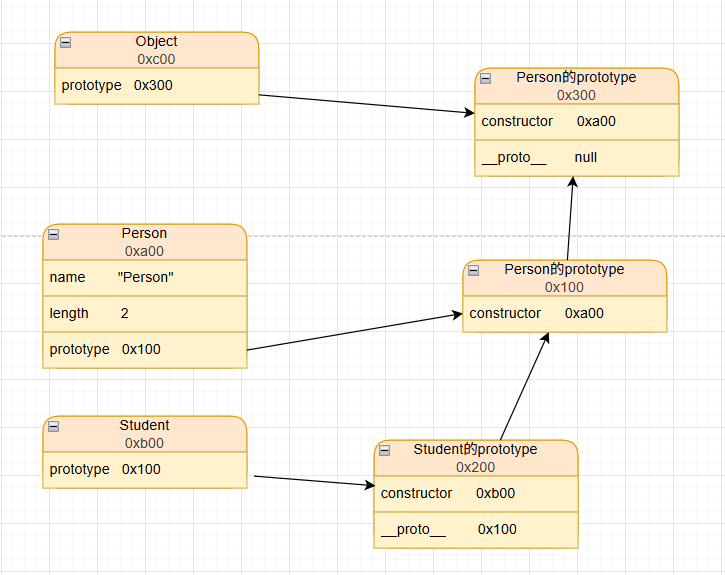
从图中可以看出,Student继承自Person,同样的,Person也继承自Object,可得Object是所有类的子类。
2.5 ES5 – 对象补充方法
-
hasOwnProperty() – 判断某个属性是否存在于对象自身,而不是原型的
obj.hasOwnProperty(“name”)
-
in操作符 – 判断某个属性是否存在于对象身上(包括原型)
“name” in obj
for…in 可遍历对象的所有可枚举属性,包括原型上的属性
-
instanceof – 用于检测构造函数的
prototype
function Person(name, age) {}function Student(name, age) {}inherit(Student, Person)const p = new Student("chender", 22)console.log(p instanceof Student) // trueconsole.log(p instanceof Person) // trueconsole.log(p instanceof Object) // true
- isPrototypeof() – 用于判断某个对象是否出现在某个实例对象的原型链上 (了解即可)
Student.prototype.isPrototypeof§ // p是否在Student.prototype的原型链上
3. 原型关系
3.1 原型继承关系图
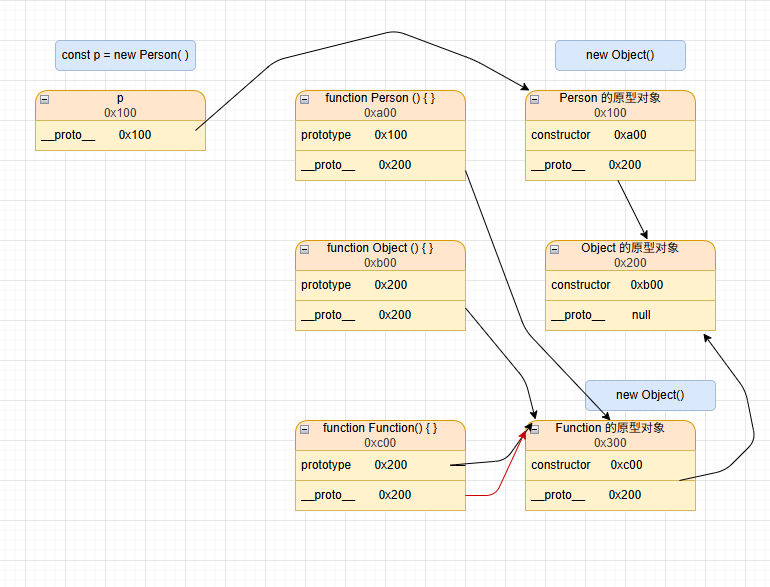

图片来源:javascript_layout_tree
注:
- 所有函数(比如Person, Object)都是Function的实例对象;
- Function也是Function的实例对象;
- 原型对象创建时默认其隐式原型指向Object的显式原型;
- 推导得:Object是Person, Function的父类
补充 – 构造函数的类方法和实例方法:
function Person(name, age) {this.name = name;this.age = age;
}// 实例方法
Person.prototype.eating = function () {console.log("eating")
}// 类方法
Person.randomPerson = function (){return new Person("abc", 18)
}const p1 = new Person("name", 18)
有了上面这段代码,现在来思考一个问题:
-
Person.eating() 会执行吗?
答案是 不会。
- 因为Person是Function的实例对象,是Object,且Person原型上没有eating方法,接着在Object原型上找也没有找到,所以会报错。
- 这种定义在构造函数原型上的方法就叫做实例方法(只有创建实例对象才能调用)。
-
const p = Person.randomPerson() 会执行吗?
答案是 会。
- 因为randomPerson方法在Person对象身上,直接调用即可获得;
- 这种定义在构造函数对象上的方法就叫做类方法。
3.2 ES6的class
3.2.1 class定义类
ES6新的标准中使用class关键字定义类。
class Person{constructor(name, age){this.name = name;this.age = age;}// 实例方法// 本质是Person.prototype.eating = function(){}eating(){console.log("eating")}// 类方法static sleeping(){console.log("sleeping")}
}
class方式定义类,创建对象和构造函数方式定义类创建对象本质上是一样,但class定义的类不能作为普通函数进行调用:
3.2.2 访问器
如何更灵活的对对象或者类的属性进行管理?我们可以使用访问器来实现。
- 对象访问器
const obj = {"_name": "chen",get name(){return this._name},set name(value){this._name = value}}// 也可以使用Object.defineProperty()进行访问器定义Object.defineProperty(obj, "name", {configurable: true,enumerable: true,get(){},set(value){}})
- 类访问器
class Person{constructor(name){this.name = name}get name(){return this.name}set name(value){this.name = value}
}
3.3 extends实现继承
class Person{constructor(name){this.name = name}say(){}
}class Student extends Person{constructor(name, age){super(name)this.age = age}
}
class中的super关键字:
- super.method(…) 来调用一个父类方法;
- super(…) 来调用父类的constructor(…)
注:
- 在子类中使用
this或者返回默认对象前必须先通过super调用父类构造函数; super的使用位置:构造函数、实例方法、类方法;super只能调用同名函数,不能调用不同名函数;
class Student extends Person {// ...static sleep() {super.sleep()// super.eat() // 报错console.log('sleeping')}}
